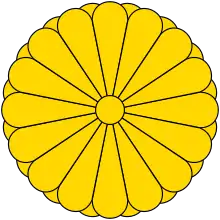Kofun period
The Kofun period (古墳時代, Kofun jidai) is an era in the history of Japan from about 300 to 538 AD (the date of the introduction of Buddhism), following the Yayoi period. The Kofun and the subsequent Asuka periods are sometimes collectively called the Yamato period. This period is the earliest era of recorded history in Japan, but studies depend heavily on archaeology since the chronology of historical sources tends to be distorted.
| History of Japan |
|---|
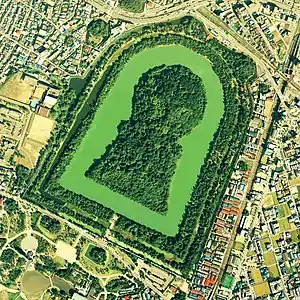 |
It was a period of cultural import. Continuing from the Yayoi period, the Kofun period is characterized by a strong influence from the Korean Peninsula; archaeologists consider it a shared culture across the southern Korean Peninsula, Kyūshū and Honshū.[1] The word kofun is Japanese for the type of burial mound dating from this era, and archaeology indicates that the mound tombs and material culture of the elite were similar throughout the region. From China, Buddhism and the Chinese writing system were introduced near the end of the period. The Kofun period recorded Japan's earliest political centralization, when the Yamato clan rose to power in southwestern Japan, established the Imperial House, and helped control trade routes across the region.[2]
Kofun tombs

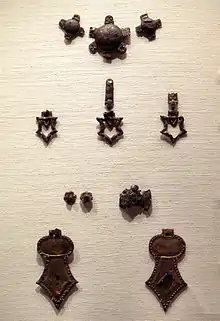
Kofun (from Middle Chinese kú 古 "ancient" + bjun 墳 "burial mound")[3][4] are burial mounds built for members of the ruling class from the 3rd to the 7th centuries in Japan,[5] and the Kofun period takes its name from the distinctive earthen mounds. The mounds contained large stone burial chambers, and some are surrounded by moats.
Kofun have four basic shapes: round and square are the most common, followed by 'scallop-shell' and 'keyhole.' The keyhole tomb is a distinct style found only in Japan, with a square front and round back. Kofun range in size from several meters to over 400 meters long, and unglazed pottery figures (Haniwa) were often buried under a kofun's circumference.
Development
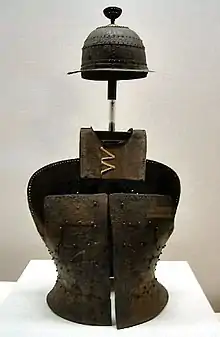
The oldest Japanese kofun is reportedly Hokenoyama Kofun in Sakurai, Nara, which dates to the late 3rd century. In the Makimuku district of Sakurai, later keyhole kofuns (Hashihaka Kofun, Shibuya Mukaiyama Kofun) were built during the early 4th century. The keyhole kofun spread from Yamato to Kawachi—with giant kofun, such as Daisenryō Kofun—and then throughout the country during the 5th century. Keyhole kofun disappeared later in the 6th century, probably because of the drastic reformation of the Yamato court; Nihon Shoki records the introduction of Buddhism at this time. The last two great kofun are the 190-metre-long (620 ft) Imashirozuka kofun in Osaka (currently believed by scholars to be the tomb of Emperor Keitai) and the 135-metre long (443 ft) Iwatoyama kofun in Fukuoka, recorded in Fudoki of Chikugo as the tomb of Iwai (political archrival of Emperor Keitai). Kofun burial mounds on the island of Tanegashima and two very old Shinto shrines on the island of Yakushima suggest that these islands were the southern boundary of the Yamato state;[2] it extended north to Tainai in the present-day Niigata Prefecture, where excavated mounds have been associated with a person closely linked to the Yamato kingdom.[6]
Yamato court
Yamato rule is usually believed to have begun about 250 AD, and it is generally agreed that Yamato rulers had keyhole-kofun culture and hegemony in Yamato until the 4th century. Autonomy of local powers remained throughout the period, particularly in Kibi (the present-day Okayama Prefecture), Izumo (current Shimane Prefecture), Koshi (current Fukui and Niigata Prefecture), Kenu (northern Kantō), Chikushi (northern Kyūshū), and Hi (central Kyūshū). During the 6th century, the Yamato clans began to dominate the southern half of Japan. According to the Book of Song, Yamato relationships with China probably began in the late 4th century.
The Yamato polity, which emerged by the late 5th century, was distinguished by powerful clans (豪族, gōzoku). Each clan was headed by a patriarch (氏上, Uji-no-kami), who performed sacred rituals to the clan's kami (objects of worship) to ensure its long-term welfare. Clan members were the aristocracy, and the royal line which controlled the Yamato court was at its zenith. Clan leaders were awarded kabane, inherited titles denoting rank and political standing which replaced family names.
The Kofun period is called the Yamato period by some Western scholars, since this local chieftainship became the imperial dynasty at the end of the period. However, the Yamato clan ruled just one polity among others during the Kofun era. Japanese archaeologists emphasise that other regional chieftainships (such as Kibi) were in close contention for dominance in the first half of the Kofun period; Kibi's Tsukuriyama Kofun is Japan's fourth-largest.

The Yamato court exercised power over clans in Kyūshū and Honshū, bestowing titles (some hereditary) on clan chieftains. The Yamato name became synonymous with Japan as Yamato rulers suppressed other clans and acquired agricultural land. Based on Chinese models (including the adoption of the Chinese written language), they began to develop a central administration and an imperial court attended by subordinate clan chieftains with no permanent capital. Powerful clans were the Soga, Katsuragi, Heguri and Koze clans in the Yamato and Bizen Provinces and the Kibi clans in the Izumo Province. The Ōtomo and Mononobe clans were military leaders, and the Nakatomi and Inbe clans handled rituals. The Soga clan provided the government's chief minister, the Ōtomo and Mononobe clans provided secondary ministers, and provincial leaders were called kuni no miyatsuko. Craftsmen were organized into guilds.
Territorial expansion
_Osaka_JPN_001.jpg.webp)
In addition to archaeological findings indicating a local monarchy in Kibi Province as an important rival, the legend of the 4th-century Prince Yamato Takeru alludes to the borders of the Yamato and battlegrounds in the region; a frontier was near the later Izumo Province (eastern present-day Shimane Prefecture). Another frontier, in Kyūshū, was apparently north of present-day Kumamoto Prefecture. According to the legend, there was an eastern land in Honshū "whose people disobeyed the imperial court" and against whom Yamato Takeru was sent to fight. It is unclear if the rival country was near the Yamato nucleus or further away. The modern-day Kai Province is mentioned as a location where prince Yamato Takeru traveled on his military expedition.
The period's northern frontier was explained in Kojiki as the legend of Shido Shōgun's (四道将軍, "Shōguns to four ways") expedition. One of four shōguns, Ōbiko set out northward to Koshi and his son Take Nunakawawake left for the eastern states. The father moved east from northern Koshi, and the son moved north; they met at Aizu, in present-day western Fukushima Prefecture. Although the legend is probably not factual, Aizu is near southern Tōhoku (the northern extent of late-4th-century keyhole-kofun culture).
Ōkimi

During the Kofun period, an aristocratic society with militaristic rulers developed. The period was a critical stage in Japan's evolution into a cohesive, recognized state. The society was most developed in the Kinai region and the eastern Setouchi Region. Japan's rulers petitioned the Chinese court for confirmation of royal titles.
While the rulers' title was officially "King", they called themselves "Ōkimi" (大王, "Great King") during this period. Inscriptions on two swords (the Inariyama and Eta Funayama Swords) read Amenoshita Shiroshimesu (治天下; "ruling Heaven and Earth") and Ōkimi, indicating that the rulers invoked the Mandate of Heaven. The title Amenoshita Shiroshimesu Ōkimi was used until the 7th century, when it was replaced by Tennō.
Clans
Many of the clans and local chieftains who made up the Yamato polity claimed descent from the imperial family or kami. Archaeological evidence for the clans is found on the Inariyama Sword, on which the bearer recorded the names of his ancestors to claim descent from Ōbiko (大彦, recorded in the Nihon Shoki as a son of Emperor Kōgen). A number of clans claimed origin in China or the Korean Peninsula.
During the 5th century, the Katsuragi clan (葛城氏, descended from the legendary grandson of Emperor Kōgen) was the most prominent power in the court and intermarried with the imperial family. After the clan declined, late in the century, it was replaced by the Ōtomo clan. When Emperor Buretsu died with no apparent heir, Ōtomo no Kanamura recommended Emperor Keitai (a distant imperial relative in Koshi Province) as the new monarch. Kanamura resigned due to the failure of his diplomatic policies, and the court was controlled by the Mononobe and Soga clans at the beginning of the Asuka period.
Society
Toraijin
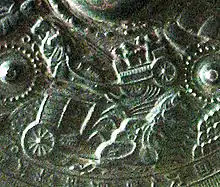
Toraijin refers to people who came to Japan from abroad, including mainland Chinese who inhabited ancient Japan via the Ryukyu Islands or the Korean Peninsula. They introduced numerous, significant aspects of Chinese culture to Japan. Valuing Chinese knowledge and culture, the Yamato government gave preferential treatment to toraijin.[7] According to the 815 book, Shinsen Shōjiroku, 317 of 1,182 clans in the Kinai region of Honshū were considered to have foreign ancestry. 163 were from China, 104 from Baekje ("Paekche" in the older romanization), 41 from Goguryeo, 6 from Silla, and 3 from Gaya.[8] They may have immigrated to Japan between 356 and 645.
Chinese migration
According to the Shinsen Shōjiroku (used as a directory of aristocrats), Chinese immigrants had considerable influence.[8] The Yamato imperial court edited the directory in 815, listing 163 Chinese clans.
According to Nihon Shoki, the Hata clan (descendants of Qin Shi Huang)[9] arrived in Yamato in 403 (the fourteenth year of Ōjin) as the vanguard of 120 provinces. According to the Shinsen Shōjiroku, the Hata clan were dispersed throughout a number of provinces during the reign of Emperor Nintoku and forced to practice sericulture and silk manufacturing for the court. When the finance ministry was set up in the Yamato court, Hata no Otsuchichi became chief of several departments (伴造; Tomo no miyatsuko) and was appointed Ministry of the Treasury (大蔵省; Okura no jo); the heads of the family were apparently financial officials of the court.
In 409 (the twentieth year of Ōjin), Achi no omi (阿知使主)—ancestor of the Yamato-Aya clan, which was also composed of Chinese immigrants—arrived with immigrants from 17 districts. According to the Shinsen Shōjiroku, Achi received permission to establish the province of Imaki. The Kawachi-no-Fumi clan, descendants of Gaozu of Han, introduced elements of Chinese writing to the Yamato court.
The Takamuko clan is descended from Cao Cao. Takamuko no Kuromaro observed the Taika Reforms.[10]
Korean migration
Some of the many Korean immigrants who settled in Japan beginning in the 4th century were the progenitors of Japanese clans. According to Kojiki and Nihon Shoki, the oldest record of a Silla immigrant is Amenohiboko: a legendary prince of Silla who settled in Japan at the era of Emperor Suinin, possibly during the 3rd or 4th centuries.
Baekje and Silla sent their princes as hostages to the Yamato court in exchange for military support.[11][12][13][14] King Muryeong of Baekje was born in Kyushu (筑紫) of Japan as the child of a hostage in 462,[15] and left a son in Japan who was an ancestor of the minor-noble Yamato no Fubito (和史, "Scribes of Yamato") clan. According to the Shoku Nihongi (続日本紀), Yamato no Fubito's relative (Takano no Niigasa) was a 10th-generation descendant of King Muryeong of Baekje who was chosen as a concubine for Emperor Kōnin and was the mother of Emperor Kanmu. In 2001, Emperor Akihito confirmed his ancient royal Korean heritage through Emperor Kanmu.[16]
Culture
Language
_from_Iizuka-machi%252C_Ota-shi%252C_Gunma_-_Tokyo_National_Museum_-_DSC06425.JPG.webp)
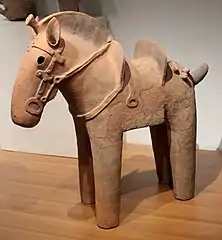
Chinese, Japanese, and Koreans wrote historical accounts primarily in Chinese characters, making original pronunciation difficult to trace. Although writing was largely unknown to the indigenous Japanese of the period, the literary skills of foreigners seem to have been increasingly appreciated by the Japanese elite. The Inariyama Sword, tentatively dated to 471 or 531, contains Chinese-character inscriptions in a style used in China at the time.[17]
Haniwa
The cavalry wore armour, carried swords and other weapons, and used advanced military methods similar to those of Northeast Asia. Evidence of the advances is seen in haniwa (埴輪, "clay ring"), clay offerings placed in a ring on and around the tomb mounds of the ruling elite. The most important of these haniwa were found in southern Honshū (especially the Kinai region around Nara Prefecture) and northern Kyūshū. Haniwa grave offerings were sculpted as horses, chickens, birds, fans, fish, houses, weapons, shields, sunshades, pillows, and male and female humans. Another funerary piece, the magatama (勾玉, "curved jewel"), became symbolic of imperial power.
Introduction of material culture
Much of the material culture of the Kofun period demonstrates that Japan was in close political and economic contact with continental Asia (especially with the southern dynasties of China) via the Korean Peninsula; bronze mirrors cast from the same mould have been found on both sides of the Tsushima Strait. Irrigation, sericulture, and weaving were brought to Japan by Chinese immigrants, who are mentioned in ancient Japanese histories; the Chinese Hata clan (秦, read "Qín" in Chinese) introduced sericulture and certain types of weaving.[18]
Asuka period
The introduction of Buddhism in 538 marked the transition from the Kofun to the Asuka period, which coincided with the reunification of China under the Sui dynasty later in the century. Japan became deeply influenced by Chinese culture, adding a cultural context to the religious distinction between the periods.
Relations with other East Asian kingdoms
Chinese records
According to the Book of Sui, Silla and Baekje greatly valued relations with the Kofun-period Wa and the Korean kingdoms made diplomatic efforts to maintain their good standing with the Japanese.[19] The Book of Song reported that a Chinese emperor appointed the five kings of Wa in 451 to supervise military Affairs of Wa, Silla, Imna, Gara, Jinhan and Mahan.[20]
Japanese records
According to the Nihon Shoki, Silla was conquered by the Japanese Empress-consort Jingū in the third century.[21] However, due to lack of evidence,[22] this story is considered to be mythological in nature. It reported that the prince of Silla came to Japan to serve the emperor of Japan,[23] and lived in Tajima Province. Known as Amenohiboko, his descendant is Tajima Mori.[24] According to Kojiki[25] and Nihon Shoki,[26] Geunchogo of Baekje presented stallions, broodmares and trainers to the Japanese emperor during Emperor Ōjin's reign.[27]
Korean records
The Samguk sagi (Chronicles of the Three Kingdoms) reported that Baekje and Silla sent their princes as hostages to the Yamato court in exchange for military support to continue their military campaigns; King Asin of Baekje sent his son (Jeonji) in 397,[28] and King Silseong of Silla sent his son Misaheun in 402.[29] Hogong, from Japan, helped to found Silla.[30]
According to the Gwanggaeto Stele, Silla and Baekje were client states of Japan. Korea says that part of the stele can be translated in four different ways, depending on punctuation and supplying missing characters.[31] The Chinese Academy of Social Sciences investigated the stele and reported that it reads, "Silla and Baekje were client states of Japan".[32]
Results of the Japan-South Korea Joint Historical Research
Under an agreement reached at the 2001 Japan-South Korea summit, Japanese and South Korean historians conducted joint historical research in two phases, including the relationship between Japan and the Korean Peninsula during the Kofun period. The point at issue was the "Mimana Nihon-fu" (任那日本府 )which was said to be the governing institution Japan established in Korea at that time. After the controversy, Japanese and South Korean historians agreed that there were Japanese in the south of Korea and that the term "Mimana Nihon-fu" (任那日本府) was not used at the time and should not be used as it was misleading. However, they could not agree on the position of the Japanese people in Korea at that time. The Japanese side claimed that the institutions established in Korea by the Japanese people were not under the control of Koreans, but were operated independently by the Japanese people and conducted diplomatic negotiations with the Gaya confederacy. On the other hand, the South Korean side claimed that the agency was the diplomatic office of Gaya, which employed the Japanese as bureaucrats of Gaya. The collaboration ended in 2010 with the publication of a final report describing the above. The full text of the minutes concerning the joint research is disclosed by the Japanese side.[33][34][35][36][37]
Gallery
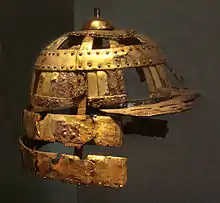 Kofun helmet, iron and gilt copper
Kofun helmet, iron and gilt copper Kofun Tankō (short armor)
Kofun Tankō (short armor)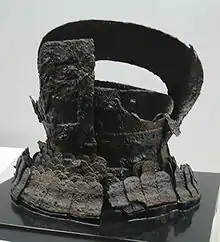 Kofun Keikō (cuirass)
Kofun Keikō (cuirass)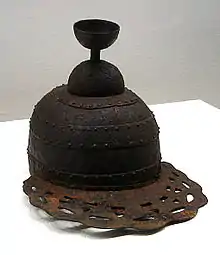 Helmet
Helmet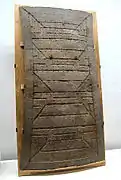 Shield
Shield Crown
Crown Restored Kofun period lamellar armour
Restored Kofun period lamellar armour
See also
Notes
- Barnes, Gina L. The Archaeology of East Asia: The Rise of Civilization in China, Korea and Japan (Oxford: Oxbow books, 2015), 271-275; 331-360
- Denoon, Donald et al. (2001). Multicultural Japan: Palaeolithic to Postmodern, p. 107., p. 107, at Google Books
- "古". Jisho.org.
- "墳". Jisho.org.
- Keally, Charles T. (2009-04-29). "Kofun Culture". Retrieved 2009-05-30.
- "Yamato kingdom traces found in Niigata Pref". Daily Yomiuri Online. September 17, 2012. Retrieved September 23, 2012.
- Kōzō, Yamamura; John Whitney Hall (1997). The Cambridge history of Japan. Cambridge University Press. p. 311. ISBN 0-521-22354-7.
- Saeki (1981)
- "Nihon no myōji 7000 ketsu seishi ruibetsu taikan Hata uji 日本の苗字7000傑 姓氏類別大観 秦氏". Archived from the original on 2006-05-17. Retrieved 2006-05-31.
- "Nihon no myōji 7000 ketsu seishi ruibetsu taikan Takamuko uji 日本の苗字7000傑 姓氏類別大観 高向氏". Archived from the original on 2006-05-17. Retrieved 2006-10-15.
- Brown, Delmer M. (1993). The Cambridge History of Japan: Ancient Japan. Cambridge University Press. p. 141. ISBN 0-521-22352-0.
Faced with this comeback by Koguryo, Paekche leaders turned to Yamato for military support, even sending its crown prince to Yamato as a hostage in 397 – just as Silla had dispatched princely hostage to Koguryo in 392 when that kingdom was in dire need of military support.
- Pratt, Keith (2007). Everlasting Flower: A History of Korea. Reaktion Books. p. 42. ISBN 978-1-86189-335-2.
We can only guess, for example, what it felt like for the girls periodically sent as brides to foreign courts, for the crown prince of Paekche when he was dispatched to the Yamato court as a hostage in AD 397, or for a Silla prince who experienced the same fate in 402.
- The New Encyclopædia Britannica. Encyclopædia Britannica. 2003. p. 279. ISBN 0-85229-961-3.
Paekche was frequently attacked by Koguryo during the century, prompting continued requests for assistance from Yamato; it is recorded that Paekche even sent a crown prince to Yamato as a hostage on one occasion and the mother of the king on another. Yet, probably because of internal dissension, Yamato did not dispatch any troops to the peninsula. Yamato's interest in Korea was apparently a desire for access to improved continental technology and resources, especially iron.
- Henthorn, William E. (1971). A history of Korea. Free Press. p. 37.
In 402, Silla concluded a peace with the Wa. Prince Misahun was then sent to Japan as a hostage. This may have been an act of revenge by the Silla monarch, who, as Prince Silsong, had been sent as hostage to Koguryo by Prince Misahun's father. Despite the peace, Silla–Wa relations were never friendly, due no doubt in part to the Wa–Kaya alliance.
- Nihon Shoki Vol.14 "Chronicle of Emperor Yūryaku" 六月丙戌朔 孕婦果如加須利君言 於Chikuzen Province (筑紫) 各羅嶋産兒 仍名此兒曰嶋君 於是 軍君即以一船 送嶋君於國 是爲King Muryeong of Baekje (武寧王) 百濟人呼此嶋曰主嶋也
- Watts, Jonathan. "The emperor's new roots: The Japanese emperor has finally laid to rest rumours that he has Korean blood, by admitting that it is true" The Guardian 28 Dec., 2001 https://www.theguardian.com/world/2001/dec/28/japan.worlddispatch
- Seeley (2000:19-23)
- 国語大辞典 (Kokugo Dai Jiten Dictionary) (in Japanese) (新装版 (Revised Edition) ed.), Tokyo: Shogakukan, 1988,
姓氏。古代の有力帰化系氏族。出自は諸説あるが、おそらく五世紀に渡来した中国人の子孫で、養蚕・機織の技術をもって朝廷に仕え、伴造(とものみやつこ)の一員として秦造(はたのみやつこ)を称したと思われる。
Surname. Influential immigrant clan in ancient times. Various theories about origins, but most likely descendants of Chinese immigrants who came to Japan in the fifth century, who are thought to have brought sericulture and weaving technologies and served in the imperial court, and to have been granted the title Hata no Miyatsuko as members of the Tomo no Miyatsuko [an imperial rank responsible for overseeing technically skilled artisans]. - Chinese History Record Book of Sui, Vol. 81, Liezhuan 46 : 隋書 東夷伝 第81巻列伝46 : 新羅、百濟皆以倭為大國,多珍物,並敬仰之,恆通使往來 "Silla and Baekje both take Wa to be a great country, with many rare and precious things; also [Silla and Baekje] respect and look up to them, and regularly send embassies there." "Archived copy". Archived from the original on 2004-12-21. Retrieved 2006-04-29.CS1 maint: archived copy as title (link)
- Chinese History Record Book of Song : 宋書 列傳第五十七 夷蠻 : 詔除武使持節、都督倭新羅任那加羅秦韓慕韓六國諸軍事、安東大將軍、倭王。興死,弟武立,自稱使持節、都督倭百濟新羅任那加羅秦韓慕韓七國諸軍事、安東大將軍、倭國王
- Sakamoto (1967:336-340)
- Joanna Rurarz (2014). Historia Korei (in Polish). Wydawnictwo Akademickie Dialog. p. 89. ISBN 9788363778866.
- Nihon Shoki, Vol.6 "天日槍對曰 僕新羅國主之子也 然聞日本國有聖皇 則以己國授弟知古而化歸(to serve)之"
- Nihon Shoki, Vol.6 "故天日槍娶但馬出嶋人 太耳女麻多烏 生但馬諸助也 諸助生但馬日楢杵 日楢杵生清彦 清彦生田道間守也"
- 百濟國主照古王遣阿知吉師獻雄馬雌馬各壹以貢上此阿知吉師者 阿直史等之祖
- 十五年秋八月 壬戌朔丁卯 百濟王遣阿直岐 貢良馬二匹 即養於輕阪上廄 因以阿直岐令掌飼 故號其養馬之處曰 廄阪
- Kurano (1958:248-249)
- Korean History Record Samguk Sagi : 三國史記 新羅本紀 : 元年 三月 與倭國通好 以奈勿王子未斯欣爲質
- Korean History Record Samguk Sagi : 三國史記 百済本紀 : 六年夏五月 王與倭國結好 以太子腆支爲質 秋七月大閱於漢水之南 "Archived copy". Archived from the original on 2008-05-12. Retrieved 2008-05-12.CS1 maint: archived copy as title (link)
- Korean History Record Samguk Sagi :三國史記 卷第一 新羅本紀第一 始祖赫居世, 瓠公者 未詳其族姓 本倭人
- 百残新羅舊是属民由来朝貢而倭以辛卯年来渡海破百残XX新羅以為臣民
- 徐建新 (2006-02-07). 好太王碑拓本の研究. 東京堂出版. ISBN 4-490-20569-4.
- Japan-Korea Joint Historical Research Committee, Japan-Korea Joint Historical Research Report (first period) The Japan Korea Cultural Foundation
- Japan-Korea Joint Historical Research Committee, Japan-Korea Joint Historical Research Report (second period) The Japan Korea Cultural Foundation
- Japan-Korea Joint Historical Research Committee, Discussion meeting of the first subcommittee, pp.479-484, August 19, 2009 The Japan Korea Cultural Foundation
- Summary of the Japan-Korea Historical Research Report 47news, March 23, 2010
- Summary of the Japan-Korea Historical Research Report Shikoku News , March 23, 2010
References
| Wikimedia Commons has media related to Kofun period. |
- Bogucki, Peter (1999). The Origins of Human Society. Blackwell Publishing. ISBN 1-57718-112-3.
- Farris, William Wayne (1998). Sacred Texts and Buried Treasures: Issues in the Historical Archaeology of Ancient Japan. University of Hawai'i Press. ISBN 0-8248-1966-7.
- Imamura, Keiji (1996). Prehistoric Japan: New Perspectives on Insular East Asia. University of Hawaii Press. ISBN 0-8248-1852-0.
- Kōzō, Yamamura; John Whitney Hall (1997). The Cambridge history of Japan. Cambridge University Press. ISBN 0-521-22354-7.
- Kurano, Kenji; Yūkichi Takeda (1958). Nihon Koten Bungaku Taikei 1: Kojiki, Norito. Iwanami Shoten. ISBN 4-00-060001-X.
- Saeki, Arikiyo (1981). Shinsen Shōjiroku no Kenkyū (Honbun hen) (in Japanese). Yoshikawa Kōbunkan. ISBN 4-642-02109-4.
- Sakamoto, Tarō; Ienaga Saburō; Inoue Mitsusada; Ōno Susumu (1967). Nihon Koten Bungaku Taikei 67: Nihon Shoki. 1. Iwanami Shoten. ISBN 4-00-060067-2.
- Seeley, Christopher (2000). A history of writing in Japan. University of Hawai'i Press. ISBN 0-8248-2217-X.
- Stearns, Peter N.; William Leonard Langer (2001). The Encyclopedia of World History. Houghton Mifflin Harcourt. ISBN 0-395-65237-5.
- Yamaguchi, Yoshinori; Kōnoshi Takamitsu (1997). Shinpen Nihon Koten Bungaku Zenshū 1: Kojiki. Shōgakukan. ISBN 4-09-658001-5.
- Yoshida, Takashi (1997). Nihon no tanjō (in Japanese). Iwanami Shoten. ISBN 4-00-430510-1.
 This article incorporates public domain material from the Library of Congress Country Studies website http://lcweb2.loc.gov/frd/cs/.
This article incorporates public domain material from the Library of Congress Country Studies website http://lcweb2.loc.gov/frd/cs/.- Japan
This period is part of the Yamato period of Japanese History.
< Yayoi | History of Japan | Asuka period >
